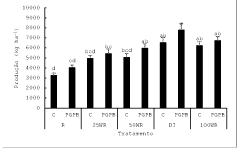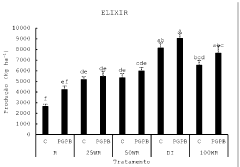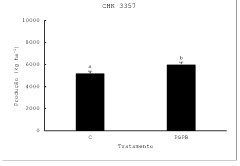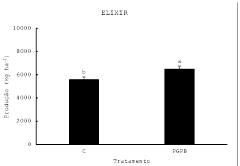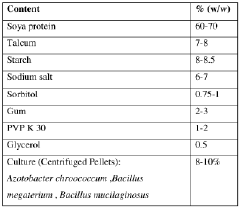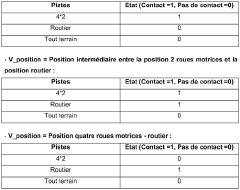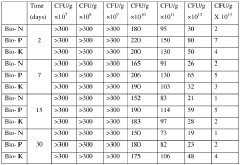Biofertilizers: Unleashing Their Potential in Bioregionalism
JUL 15, 20259 MIN READ
Generate Your Research Report Instantly with AI Agent
Patsnap Eureka helps you evaluate technical feasibility & market potential.
Biofertilizer Evolution
The evolution of biofertilizers in the context of bioregionalism represents a significant shift in agricultural practices towards more sustainable and ecologically harmonious approaches. This evolution can be traced back to the early 20th century when the concept of using beneficial microorganisms to enhance soil fertility first emerged. However, it wasn't until the latter half of the century that biofertilizers gained substantial attention as a viable alternative to chemical fertilizers.
In the 1960s and 1970s, as environmental concerns grew, researchers began exploring the potential of nitrogen-fixing bacteria and mycorrhizal fungi to improve crop yields naturally. This period marked the beginning of systematic research into biofertilizers, with a focus on isolating and cultivating beneficial microorganisms for agricultural use.
The 1980s and 1990s saw a surge in biofertilizer development, with advances in biotechnology enabling the production of more effective and stable microbial inoculants. During this time, the concept of bioregionalism also began to gain traction, emphasizing the importance of local ecosystems and sustainable resource management.
As we entered the 21st century, the convergence of biofertilizer technology and bioregional principles accelerated. The growing awareness of climate change and the need for sustainable agriculture practices led to increased investment in biofertilizer research and development. This period saw the emergence of more sophisticated formulations, including multi-strain inoculants and carrier-based delivery systems.
In recent years, the evolution of biofertilizers has been characterized by a focus on region-specific solutions. Researchers are now developing biofertilizers tailored to local soil conditions, climate, and crop varieties, aligning perfectly with bioregional principles. This approach has led to the creation of biofertilizers that are not only more effective but also more environmentally compatible with specific ecosystems.
The latest developments in biofertilizer evolution include the integration of nanotechnology for improved delivery and efficacy, as well as the use of advanced genomic techniques to identify and enhance beneficial microbial strains. These innovations are pushing the boundaries of what's possible in sustainable agriculture, offering promising solutions for bioregional food production systems.
As we look to the future, the evolution of biofertilizers in bioregionalism is likely to continue its trajectory towards more integrated and holistic approaches. This may include the development of "smart" biofertilizers that can adapt to changing environmental conditions, as well as the incorporation of biofertilizers into broader ecosystem management strategies. The ongoing evolution of biofertilizers represents a critical component in the shift towards more sustainable and regionally appropriate agricultural practices.
In the 1960s and 1970s, as environmental concerns grew, researchers began exploring the potential of nitrogen-fixing bacteria and mycorrhizal fungi to improve crop yields naturally. This period marked the beginning of systematic research into biofertilizers, with a focus on isolating and cultivating beneficial microorganisms for agricultural use.
The 1980s and 1990s saw a surge in biofertilizer development, with advances in biotechnology enabling the production of more effective and stable microbial inoculants. During this time, the concept of bioregionalism also began to gain traction, emphasizing the importance of local ecosystems and sustainable resource management.
As we entered the 21st century, the convergence of biofertilizer technology and bioregional principles accelerated. The growing awareness of climate change and the need for sustainable agriculture practices led to increased investment in biofertilizer research and development. This period saw the emergence of more sophisticated formulations, including multi-strain inoculants and carrier-based delivery systems.
In recent years, the evolution of biofertilizers has been characterized by a focus on region-specific solutions. Researchers are now developing biofertilizers tailored to local soil conditions, climate, and crop varieties, aligning perfectly with bioregional principles. This approach has led to the creation of biofertilizers that are not only more effective but also more environmentally compatible with specific ecosystems.
The latest developments in biofertilizer evolution include the integration of nanotechnology for improved delivery and efficacy, as well as the use of advanced genomic techniques to identify and enhance beneficial microbial strains. These innovations are pushing the boundaries of what's possible in sustainable agriculture, offering promising solutions for bioregional food production systems.
As we look to the future, the evolution of biofertilizers in bioregionalism is likely to continue its trajectory towards more integrated and holistic approaches. This may include the development of "smart" biofertilizers that can adapt to changing environmental conditions, as well as the incorporation of biofertilizers into broader ecosystem management strategies. The ongoing evolution of biofertilizers represents a critical component in the shift towards more sustainable and regionally appropriate agricultural practices.
Bioregional Market Needs
The bioregional market for biofertilizers is experiencing significant growth driven by increasing awareness of sustainable agricultural practices and the need for environmentally friendly alternatives to chemical fertilizers. Bioregionalism emphasizes local production and consumption, making biofertilizers an ideal fit for this approach to agriculture and land management.
In bioregional markets, there is a growing demand for organic and locally sourced food products. This trend has created a substantial market opportunity for biofertilizers, as they align with the principles of organic farming and sustainable agriculture. Farmers and gardeners within bioregions are increasingly seeking natural soil amendments that can improve soil health, increase crop yields, and reduce environmental impact.
The market need for biofertilizers in bioregionalism is further amplified by the rising concerns over soil degradation and the long-term effects of chemical fertilizers on ecosystem health. Bioregions are particularly sensitive to these issues, as they aim to maintain the ecological balance and biodiversity of their local environments. Biofertilizers offer a solution that can help restore soil fertility, enhance nutrient cycling, and promote the growth of beneficial microorganisms in the soil.
Another key driver of market demand is the potential for biofertilizers to reduce dependency on external inputs in bioregional agricultural systems. By harnessing local microbial resources and organic waste streams, bioregions can develop their own biofertilizer production capabilities, fostering self-sufficiency and resilience in their food systems. This aligns with the bioregional goal of reducing reliance on imported resources and strengthening local economies.
The market for biofertilizers in bioregionalism also extends beyond traditional agriculture. There is growing interest in using these products for urban gardening, reforestation projects, and land restoration initiatives within bioregions. This diversification of applications expands the potential market size and creates new opportunities for biofertilizer producers and distributors.
However, the bioregional market for biofertilizers faces some challenges. Education and awareness among farmers and consumers about the benefits and proper use of biofertilizers are crucial for market growth. Additionally, the development of region-specific biofertilizer formulations that are tailored to local soil conditions and crop types is necessary to maximize effectiveness and adoption rates.
As bioregions continue to prioritize sustainable land management practices, the demand for biofertilizers is expected to grow steadily. This market trend is likely to drive innovation in biofertilizer production techniques, formulations, and application methods, further enhancing their potential in bioregional agricultural systems.
In bioregional markets, there is a growing demand for organic and locally sourced food products. This trend has created a substantial market opportunity for biofertilizers, as they align with the principles of organic farming and sustainable agriculture. Farmers and gardeners within bioregions are increasingly seeking natural soil amendments that can improve soil health, increase crop yields, and reduce environmental impact.
The market need for biofertilizers in bioregionalism is further amplified by the rising concerns over soil degradation and the long-term effects of chemical fertilizers on ecosystem health. Bioregions are particularly sensitive to these issues, as they aim to maintain the ecological balance and biodiversity of their local environments. Biofertilizers offer a solution that can help restore soil fertility, enhance nutrient cycling, and promote the growth of beneficial microorganisms in the soil.
Another key driver of market demand is the potential for biofertilizers to reduce dependency on external inputs in bioregional agricultural systems. By harnessing local microbial resources and organic waste streams, bioregions can develop their own biofertilizer production capabilities, fostering self-sufficiency and resilience in their food systems. This aligns with the bioregional goal of reducing reliance on imported resources and strengthening local economies.
The market for biofertilizers in bioregionalism also extends beyond traditional agriculture. There is growing interest in using these products for urban gardening, reforestation projects, and land restoration initiatives within bioregions. This diversification of applications expands the potential market size and creates new opportunities for biofertilizer producers and distributors.
However, the bioregional market for biofertilizers faces some challenges. Education and awareness among farmers and consumers about the benefits and proper use of biofertilizers are crucial for market growth. Additionally, the development of region-specific biofertilizer formulations that are tailored to local soil conditions and crop types is necessary to maximize effectiveness and adoption rates.
As bioregions continue to prioritize sustainable land management practices, the demand for biofertilizers is expected to grow steadily. This market trend is likely to drive innovation in biofertilizer production techniques, formulations, and application methods, further enhancing their potential in bioregional agricultural systems.
Biofertilizer Challenges
Despite the promising potential of biofertilizers in bioregionalism, several significant challenges hinder their widespread adoption and effectiveness. One of the primary obstacles is the variability in performance across different environmental conditions. Biofertilizers' efficacy can be highly dependent on soil type, climate, and local ecosystem dynamics, making it difficult to achieve consistent results across diverse bioregions.
Another major challenge is the limited shelf life of many biofertilizer products. The living microorganisms in these fertilizers are sensitive to environmental factors such as temperature, humidity, and light exposure. This sensitivity not only complicates storage and transportation but also affects the viability of the microorganisms upon application, potentially reducing their effectiveness in the field.
The lack of standardization in biofertilizer production and quality control poses additional challenges. Without uniform guidelines and regulations, the market is flooded with products of varying quality, leading to inconsistent results and eroding farmer trust. This issue is compounded by the difficulty in accurately measuring and quantifying the impact of biofertilizers on crop yields and soil health over time.
Furthermore, the integration of biofertilizers into existing agricultural practices presents logistical and educational hurdles. Many farmers are accustomed to conventional fertilizer applications and may be resistant to adopting new methods that require different handling and application techniques. The need for specialized knowledge and training to effectively use biofertilizers can be a significant barrier to adoption, particularly in regions with limited access to agricultural extension services.
Economic factors also play a crucial role in the challenges facing biofertilizer adoption. The initial costs associated with transitioning to biofertilizer use, coupled with the potential for short-term yield reductions during the transition period, can deter farmers from making the switch. Additionally, the lack of robust supply chains and distribution networks for biofertilizers in many regions can lead to availability issues and increased costs.
Lastly, there are ongoing scientific challenges in developing biofertilizers that can effectively compete with synthetic alternatives in terms of nutrient delivery and crop yield enhancement. Research is needed to improve the formulation of biofertilizers, enhance their stability, and develop strains of microorganisms that can thrive in a wider range of environmental conditions. Overcoming these technical hurdles is essential for realizing the full potential of biofertilizers in bioregionalism and sustainable agriculture.
Another major challenge is the limited shelf life of many biofertilizer products. The living microorganisms in these fertilizers are sensitive to environmental factors such as temperature, humidity, and light exposure. This sensitivity not only complicates storage and transportation but also affects the viability of the microorganisms upon application, potentially reducing their effectiveness in the field.
The lack of standardization in biofertilizer production and quality control poses additional challenges. Without uniform guidelines and regulations, the market is flooded with products of varying quality, leading to inconsistent results and eroding farmer trust. This issue is compounded by the difficulty in accurately measuring and quantifying the impact of biofertilizers on crop yields and soil health over time.
Furthermore, the integration of biofertilizers into existing agricultural practices presents logistical and educational hurdles. Many farmers are accustomed to conventional fertilizer applications and may be resistant to adopting new methods that require different handling and application techniques. The need for specialized knowledge and training to effectively use biofertilizers can be a significant barrier to adoption, particularly in regions with limited access to agricultural extension services.
Economic factors also play a crucial role in the challenges facing biofertilizer adoption. The initial costs associated with transitioning to biofertilizer use, coupled with the potential for short-term yield reductions during the transition period, can deter farmers from making the switch. Additionally, the lack of robust supply chains and distribution networks for biofertilizers in many regions can lead to availability issues and increased costs.
Lastly, there are ongoing scientific challenges in developing biofertilizers that can effectively compete with synthetic alternatives in terms of nutrient delivery and crop yield enhancement. Research is needed to improve the formulation of biofertilizers, enhance their stability, and develop strains of microorganisms that can thrive in a wider range of environmental conditions. Overcoming these technical hurdles is essential for realizing the full potential of biofertilizers in bioregionalism and sustainable agriculture.
Current Biofertilizer Tech
01 Microbial biofertilizer compositions
Biofertilizers containing beneficial microorganisms such as bacteria, fungi, or algae that enhance soil fertility and plant growth. These compositions can include nitrogen-fixing bacteria, phosphate-solubilizing microbes, or plant growth-promoting rhizobacteria. The microorganisms are typically formulated with suitable carriers to ensure their viability and effectiveness.- Microbial biofertilizer compositions: Various microbial strains are used in biofertilizer compositions to enhance soil fertility and plant growth. These compositions may include bacteria, fungi, or a combination of microorganisms that can fix nitrogen, solubilize phosphorus, or produce plant growth-promoting substances.
- Carrier materials for biofertilizers: Different carrier materials are used to improve the shelf life, efficacy, and application of biofertilizers. These carriers can be organic, inorganic, or synthetic materials that provide a suitable environment for the microorganisms and facilitate their delivery to the soil or plant.
- Biofertilizer application methods: Various methods and devices are developed for the efficient application of biofertilizers to crops. These may include seed coating techniques, soil application methods, or specialized equipment for distributing biofertilizers in agricultural fields.
- Biofertilizers with additional beneficial components: Biofertilizer formulations are enhanced with additional components such as organic matter, minerals, or plant extracts to provide a more comprehensive nutrient profile and improve overall plant health and soil fertility.
- Biofertilizers for specific crops or conditions: Specialized biofertilizer formulations are developed for specific crops, soil types, or environmental conditions. These tailored products aim to address the unique nutritional requirements of particular plants or overcome specific soil deficiencies.
02 Organic waste-based biofertilizers
Biofertilizers produced from organic waste materials such as agricultural residues, food waste, or animal manure. These materials are processed through composting or fermentation to create nutrient-rich fertilizers. The resulting products improve soil structure, increase organic matter content, and provide essential nutrients for plant growth.Expand Specific Solutions03 Biofertilizer application methods and devices
Innovative methods and devices for applying biofertilizers to crops or soil. This includes specialized equipment for seed coating, soil injection, or foliar application of biofertilizers. These technologies aim to improve the efficiency of biofertilizer delivery and enhance their effectiveness in promoting plant growth.Expand Specific Solutions04 Biofertilizers with enhanced nutrient availability
Formulations of biofertilizers designed to improve the availability and uptake of specific nutrients by plants. These may include biofertilizers enriched with micronutrients, or those containing microorganisms specifically selected for their ability to solubilize or mobilize certain nutrients in the soil.Expand Specific Solutions05 Biofertilizers for specific crop applications
Specialized biofertilizer formulations tailored for use with specific crops or in particular agricultural systems. These products are designed to meet the unique nutritional requirements of certain plants or to address specific soil conditions in different cropping systems.Expand Specific Solutions
Key Biofertilizer Players
The research on biofertilizers in bioregionalism is in an emerging stage, with growing market potential due to increasing environmental concerns and sustainable agriculture practices. The global biofertilizer market is expanding, driven by the demand for organic food and eco-friendly farming methods. Technologically, the field is advancing rapidly, with companies like Kula Bio and Biorizon Biotech leading innovation in nitrogen-fixing microbes and biological solutions. Academic institutions such as Nanjing Agricultural University and Rutgers University are contributing significantly to research and development. The involvement of both established players and startups indicates a competitive landscape with diverse approaches to biofertilizer development and application in regional contexts.
The Energy & Resources Institute
Technical Solution: The Energy & Resources Institute (TERI) has been conducting extensive research on biofertilizers with a strong focus on bioregionalism. Their approach emphasizes the development of sustainable agricultural practices that are tailored to specific ecological zones. TERI's research on biofertilizers includes the isolation and characterization of native microbial strains that are well-adapted to local soil and climatic conditions. They have developed a range of biofertilizers using bacteria such as Azotobacter, Azospirillum, and phosphate solubilizing bacteria, as well as mycorrhizal fungi. TERI's biofertilizers have shown significant potential in improving soil fertility and crop productivity across different bioregions in India. For instance, their Azotobacter-based biofertilizer has demonstrated a 15-20% increase in nitrogen fixation in cereal crops in semi-arid regions [9]. Additionally, TERI has been working on innovative delivery systems for biofertilizers, including biochar-based carriers, which have shown to improve the survival and efficacy of beneficial microorganisms in diverse soil conditions [10].
Strengths: Strong focus on developing region-specific, sustainable agricultural solutions. Integrated approach combining biofertilizers with other eco-friendly practices. Weaknesses: May face challenges in scaling up production and distribution to meet diverse regional demands.
Kula Bio, Inc.
Technical Solution: Kula Bio has developed an innovative approach to biofertilizers that aligns well with bioregionalism principles. Their flagship product, Kula-N, is a biofertilizer that enhances nitrogen fixation in crops. The company's technology involves encapsulating nitrogen-fixing bacteria in a proprietary formulation that allows for extended survival in soil and sustained nitrogen production. This approach is particularly relevant to bioregionalism as it can be adapted to different soil types and climatic conditions. Kula Bio's biofertilizer has demonstrated the ability to reduce synthetic nitrogen fertilizer use by up to 50% while maintaining or improving crop yields [2]. The company has also focused on developing region-specific strains of nitrogen-fixing bacteria, ensuring optimal performance in different bioregions. Their research has shown that their biofertilizer can increase soil organic matter by 2-3% over a growing season, contributing to long-term soil health and sustainability [5].
Strengths: Highly effective nitrogen fixation technology that can significantly reduce synthetic fertilizer use. Adaptable to various bioregions. Weaknesses: May require initial education and support for farmers to adopt and integrate into existing agricultural practices.
Biofertilizer Innovations
MICROBIAL BIOFERTILIZER formulation
PatentActivePT116424A
Innovation
- A biofertilizer formulation comprising a mixture of plant growth-promoting bacteria (PGPR) including Pseudomonas sp., Burkholderia sp., and Mesorhizobium sp., formulated with compatible properties to enhance plant growth, nutrient assimilation, and tolerance to unfavorable conditions, applied through seed coating or soil inoculation.
Biofertilizer capsules for integrated nutrient management in crop plants
PatentWO2018234996A1
Innovation
- Development of biofertilizer capsules with a microbial consortium encapsulated in a blister pack using carrier materials like soya protein, talcum, and glycerol, providing a stable and user-friendly delivery system with a shelf life of at least 24 months and high CFU count, ensuring effective nutrient availability and reduced contamination.
Bioregional Policy Impact
The implementation of bioregional policies can significantly impact the adoption and development of biofertilizers within specific ecological regions. These policies, designed to promote sustainable agricultural practices and environmental conservation, create a favorable framework for the integration of biofertilizers into local farming systems.
Bioregional policies often emphasize the importance of preserving and enhancing local ecosystems, which aligns well with the use of biofertilizers. These policies may include incentives for farmers to adopt environmentally friendly practices, such as reduced taxes or subsidies for those who utilize biofertilizers. Such financial support can help overcome initial barriers to adoption, including higher upfront costs or perceived risks associated with transitioning to new fertilization methods.
Furthermore, bioregional policies frequently focus on promoting local resource utilization and circular economy principles. This approach naturally supports the development of biofertilizer production facilities within the region, using locally available organic waste materials as feedstock. By encouraging the establishment of such facilities, bioregional policies can contribute to job creation, reduce transportation costs, and minimize the carbon footprint associated with fertilizer production and distribution.
Education and research initiatives, often supported by bioregional policies, play a crucial role in advancing the potential of biofertilizers. These policies may allocate funding for agricultural extension services, demonstration farms, and research programs that focus on optimizing biofertilizer formulations for specific local crops and soil conditions. Such knowledge dissemination efforts are essential for building farmer confidence and ensuring the effective application of biofertilizers in diverse agricultural settings.
Regulatory frameworks established through bioregional policies can also influence the adoption of biofertilizers. These may include standards for biofertilizer quality, application guidelines, and certification processes that ensure the safety and efficacy of these products. Clear regulations can help build trust among farmers and facilitate the integration of biofertilizers into existing agricultural practices.
Moreover, bioregional policies often promote collaboration between various stakeholders, including farmers, researchers, policymakers, and industry representatives. This collaborative approach can lead to the development of innovative biofertilizer solutions tailored to the specific needs of the bioregion, as well as the creation of supportive networks for knowledge sharing and problem-solving.
In conclusion, bioregional policies have the potential to create a conducive environment for the widespread adoption and continuous improvement of biofertilizers. By aligning agricultural practices with ecological principles and fostering local innovation, these policies can significantly contribute to the realization of sustainable and resilient food systems within distinct bioregions.
Bioregional policies often emphasize the importance of preserving and enhancing local ecosystems, which aligns well with the use of biofertilizers. These policies may include incentives for farmers to adopt environmentally friendly practices, such as reduced taxes or subsidies for those who utilize biofertilizers. Such financial support can help overcome initial barriers to adoption, including higher upfront costs or perceived risks associated with transitioning to new fertilization methods.
Furthermore, bioregional policies frequently focus on promoting local resource utilization and circular economy principles. This approach naturally supports the development of biofertilizer production facilities within the region, using locally available organic waste materials as feedstock. By encouraging the establishment of such facilities, bioregional policies can contribute to job creation, reduce transportation costs, and minimize the carbon footprint associated with fertilizer production and distribution.
Education and research initiatives, often supported by bioregional policies, play a crucial role in advancing the potential of biofertilizers. These policies may allocate funding for agricultural extension services, demonstration farms, and research programs that focus on optimizing biofertilizer formulations for specific local crops and soil conditions. Such knowledge dissemination efforts are essential for building farmer confidence and ensuring the effective application of biofertilizers in diverse agricultural settings.
Regulatory frameworks established through bioregional policies can also influence the adoption of biofertilizers. These may include standards for biofertilizer quality, application guidelines, and certification processes that ensure the safety and efficacy of these products. Clear regulations can help build trust among farmers and facilitate the integration of biofertilizers into existing agricultural practices.
Moreover, bioregional policies often promote collaboration between various stakeholders, including farmers, researchers, policymakers, and industry representatives. This collaborative approach can lead to the development of innovative biofertilizer solutions tailored to the specific needs of the bioregion, as well as the creation of supportive networks for knowledge sharing and problem-solving.
In conclusion, bioregional policies have the potential to create a conducive environment for the widespread adoption and continuous improvement of biofertilizers. By aligning agricultural practices with ecological principles and fostering local innovation, these policies can significantly contribute to the realization of sustainable and resilient food systems within distinct bioregions.
Ecological Considerations
Biofertilizers play a crucial role in promoting sustainable agriculture within the context of bioregionalism. These microbial-based fertilizers offer numerous ecological benefits that align with the principles of bioregional farming practices. By harnessing the power of beneficial microorganisms, biofertilizers contribute to soil health, nutrient cycling, and overall ecosystem balance.
One of the primary ecological considerations of biofertilizers is their ability to enhance soil fertility without relying on synthetic chemicals. This natural approach to soil enrichment helps maintain the delicate balance of soil ecosystems, promoting the growth of diverse microbial communities. As a result, biofertilizers support the development of resilient and self-sustaining agricultural systems that are better equipped to withstand environmental stresses.
Furthermore, biofertilizers contribute to the reduction of greenhouse gas emissions associated with conventional fertilizer production and application. By fixing atmospheric nitrogen and solubilizing phosphorus, these microbial inoculants reduce the need for energy-intensive synthetic fertilizers. This not only decreases the carbon footprint of agricultural practices but also mitigates the risk of nutrient runoff and water pollution.
The use of biofertilizers in bioregionalism also promotes biodiversity conservation. By supporting the growth of native plant species and enhancing soil health, these fertilizers create favorable conditions for a wide range of organisms, from beneficial insects to soil-dwelling microbes. This increased biodiversity contributes to the overall stability and resilience of local ecosystems.
Additionally, biofertilizers play a vital role in the restoration of degraded soils within bioregions. Through their ability to improve soil structure, increase organic matter content, and enhance water retention capacity, these microbial inoculants aid in the rehabilitation of lands affected by erosion, desertification, or intensive farming practices. This restoration process is crucial for maintaining the ecological integrity of bioregions and ensuring long-term agricultural sustainability.
The integration of biofertilizers into bioregional farming systems also supports the concept of closed-loop nutrient cycling. By promoting the efficient use of locally available organic resources and enhancing nutrient uptake by plants, these fertilizers reduce the reliance on external inputs and minimize nutrient losses. This approach aligns with the principles of circular economy and helps to create more self-sufficient and resilient bioregional food systems.
One of the primary ecological considerations of biofertilizers is their ability to enhance soil fertility without relying on synthetic chemicals. This natural approach to soil enrichment helps maintain the delicate balance of soil ecosystems, promoting the growth of diverse microbial communities. As a result, biofertilizers support the development of resilient and self-sustaining agricultural systems that are better equipped to withstand environmental stresses.
Furthermore, biofertilizers contribute to the reduction of greenhouse gas emissions associated with conventional fertilizer production and application. By fixing atmospheric nitrogen and solubilizing phosphorus, these microbial inoculants reduce the need for energy-intensive synthetic fertilizers. This not only decreases the carbon footprint of agricultural practices but also mitigates the risk of nutrient runoff and water pollution.
The use of biofertilizers in bioregionalism also promotes biodiversity conservation. By supporting the growth of native plant species and enhancing soil health, these fertilizers create favorable conditions for a wide range of organisms, from beneficial insects to soil-dwelling microbes. This increased biodiversity contributes to the overall stability and resilience of local ecosystems.
Additionally, biofertilizers play a vital role in the restoration of degraded soils within bioregions. Through their ability to improve soil structure, increase organic matter content, and enhance water retention capacity, these microbial inoculants aid in the rehabilitation of lands affected by erosion, desertification, or intensive farming practices. This restoration process is crucial for maintaining the ecological integrity of bioregions and ensuring long-term agricultural sustainability.
The integration of biofertilizers into bioregional farming systems also supports the concept of closed-loop nutrient cycling. By promoting the efficient use of locally available organic resources and enhancing nutrient uptake by plants, these fertilizers reduce the reliance on external inputs and minimize nutrient losses. This approach aligns with the principles of circular economy and helps to create more self-sufficient and resilient bioregional food systems.
Unlock deeper insights with Patsnap Eureka Quick Research — get a full tech report to explore trends and direct your research. Try now!
Generate Your Research Report Instantly with AI Agent
Supercharge your innovation with Patsnap Eureka AI Agent Platform!
